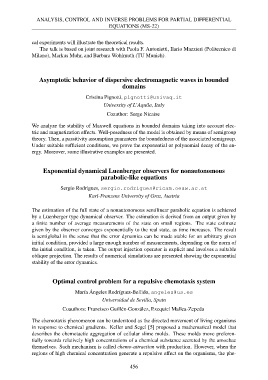Page 458 - 8th European Congress of Mathematics ∙ 20-26 June 2021 ∙ Portorož, Slovenia ∙ Book of Abstracts
P. 458
NALYSIS, CONTROL AND INVERSE PROBLEMS FOR PARTIAL DIFFERENTIAL
EQUATIONS (MS-22)
cal experiments will illustrate the theoretical results.
The talk is based on joint research with Paola F. Antonietti, Ilario Mazzieri (Politecnico di
Milano), Markus Muhr, and Barbara Wohlmuth (TU Munich).
Asymptotic behavior of dispersive electromagnetic waves in bounded
domains
Cristina Pignotti, pignotti@univaq.it
University of L’Aquila, Italy
Coauthor: Serge Nicaise
We analyze the stability of Maxwell equations in bounded domains taking into account elec-
tric and magnetization effects. Well-posedness of the model is obtained by means of semigroup
theory. Then, a passitivity assumption guarantees the boundedness of the associated semigroup.
Under suitable sufficient conditions, we prove the exponential or polynomial decay of the en-
ergy. Moreover, some illustrative examples are presented.
Exponential dynamical Luenberger observers for nonautonomous
parabolic-like equations
Sergio Rodrigues, sergio.rodrigues@ricam.oeaw.ac.at
Karl-Franzens University of Graz, Austria
The estimation of the full state of a nonautonomous semilinear parabolic equation is achieved
by a Luenberger type dynamical observer. The estimation is derived from an output given by
a finite number of average measurements of the state on small regions. The state estimate
given by the observer converges exponentially to the real state, as time increases. The result
is semiglobal in the sense that the error dynamics can be made stable for an arbitrary given
initial condition, provided a large enough number of measurements, depending on the norm of
the initial condition, is taken. The output injection operator is explicit and involves a suitable
oblique projection. The results of numerical simulations are presented showing the exponential
stability of the error dynamics.
Optimal control problem for a repulsive chemotaxis system
María Ángeles Rodríguez-Bellido, angeles@us.es
Universidad de Sevilla, Spain
Coauthors: Francisco Guillén-González, Exequiel Mallea-Zepeda
The chemotaxis phenomenon can be understood as the directed movement of living organisms
in response to chemical gradients. Keller and Segel [5] proposed a mathematical model that
describes the chemotactic aggregation of cellular slime molds. These molds move preferen-
tially towards relatively high concentrations of a chemical substance secreted by the amoebae
themselves. Such mechanism is called chemo-attraction with production. However, when the
regions of high chemical concentration generate a repulsive effect on the organisms, the phe-
456
EQUATIONS (MS-22)
cal experiments will illustrate the theoretical results.
The talk is based on joint research with Paola F. Antonietti, Ilario Mazzieri (Politecnico di
Milano), Markus Muhr, and Barbara Wohlmuth (TU Munich).
Asymptotic behavior of dispersive electromagnetic waves in bounded
domains
Cristina Pignotti, pignotti@univaq.it
University of L’Aquila, Italy
Coauthor: Serge Nicaise
We analyze the stability of Maxwell equations in bounded domains taking into account elec-
tric and magnetization effects. Well-posedness of the model is obtained by means of semigroup
theory. Then, a passitivity assumption guarantees the boundedness of the associated semigroup.
Under suitable sufficient conditions, we prove the exponential or polynomial decay of the en-
ergy. Moreover, some illustrative examples are presented.
Exponential dynamical Luenberger observers for nonautonomous
parabolic-like equations
Sergio Rodrigues, sergio.rodrigues@ricam.oeaw.ac.at
Karl-Franzens University of Graz, Austria
The estimation of the full state of a nonautonomous semilinear parabolic equation is achieved
by a Luenberger type dynamical observer. The estimation is derived from an output given by
a finite number of average measurements of the state on small regions. The state estimate
given by the observer converges exponentially to the real state, as time increases. The result
is semiglobal in the sense that the error dynamics can be made stable for an arbitrary given
initial condition, provided a large enough number of measurements, depending on the norm of
the initial condition, is taken. The output injection operator is explicit and involves a suitable
oblique projection. The results of numerical simulations are presented showing the exponential
stability of the error dynamics.
Optimal control problem for a repulsive chemotaxis system
María Ángeles Rodríguez-Bellido, angeles@us.es
Universidad de Sevilla, Spain
Coauthors: Francisco Guillén-González, Exequiel Mallea-Zepeda
The chemotaxis phenomenon can be understood as the directed movement of living organisms
in response to chemical gradients. Keller and Segel [5] proposed a mathematical model that
describes the chemotactic aggregation of cellular slime molds. These molds move preferen-
tially towards relatively high concentrations of a chemical substance secreted by the amoebae
themselves. Such mechanism is called chemo-attraction with production. However, when the
regions of high chemical concentration generate a repulsive effect on the organisms, the phe-
456


